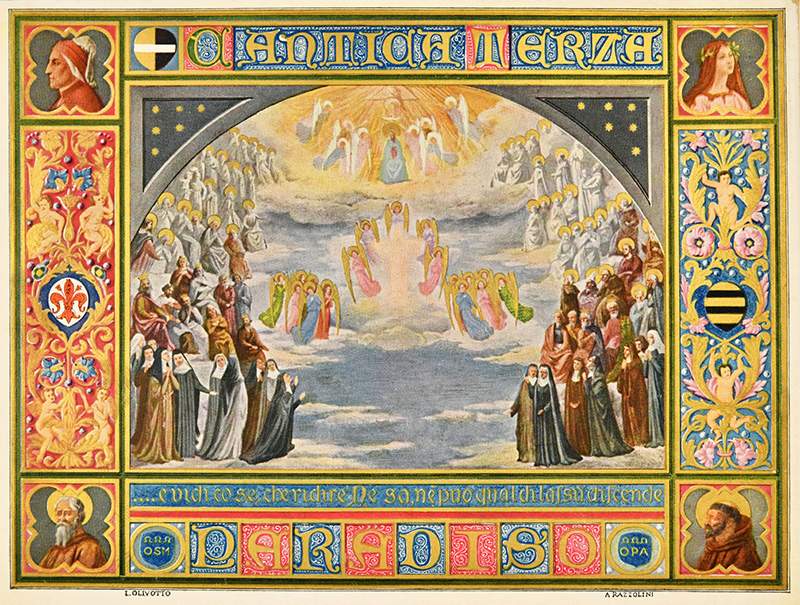From September 10 to December 3, 2022, the Classense Library in Ravenna presents the exhibition Il Paradiso degli italiani, curated by Floriana Amicucci and Daniela Poggiali, conservator and head of the Classense Library’s graphic collections, respectively. The exhibition concludes the trilogy that began in 2017 withInferno and continued in 2019 with Purgatorio and comes at the end of the 2021 celebrations for the seven hundredth anniversary of Dante’s death, following the major Dante exhibitions proposed by the Classense Library.
The theme of Il Paradiso degli italiani is precisely Dante’s Paradise, the end of the journey and the overcoming of the limits of human nature, the realm of grace and light. The exhibition focuses on Italian editions, including by foreign authors, of The Comedy from the early 19th century to 2021, but there is also an excursus on foreign illustrated editions. The volumes on display, belonging to the Classense Library’s holdings, present a selection that juxtaposes the most famous versions by the great nineteenth-century illustrators with popular comic strip reductions, graphic novels and manga, illustrations of a purely artistic nature with those that are lighter and related to Dante’s cult. In addition to the volumes, a selection of graphic and photographic series from the second half of the nineteenth century is offered.
The exhibition kicks off with the graphic interpretations of John Flaxman and continues with the visions of nineteenth-century masters Gustave Dorè and Francesco Scaramuzza whose work, extensively documented in Classense, is also displayed in a series of loose photographic prints. Among the celebrated 19th-century editions is a tribute to the Ravenna poet and man of letters Paolo Costa and the illustrated edition of his Commentary on the Divine Comedy. The secentenary of Dante’s birth is commemorated by the edition commented on by Niccolò Tommaseo and illustrated by, among others, Federico Faruffini.
The twentieth century opens with the Commedia published by Fratelli Alinari, with contributions from the best Italian artists of the early century including Libero Andreotti, Adolfo De Carolis and Duilio Cambellotti, and Alberto Martini. Significant for the popular diffusion of the illustrations of the Comedy is the edition consisting of the reproduction of the hundred postcards made at the end of the previous century by the Tuscan painter Attilio Razzolini. In the mid-twentieth century is the work of Giovanni Battista Galizzi, to which are added the woodcut headpieces by Bruno da Osimo. Equally significant was the fortune of the edition “for the use of youth” with illustrations by Manfredo Manfredini and Tancredi Scarpelli, which had as many as twelve publications from the early twentieth century until the 1960s.
Marcello’s comic strips and Go Nagai ’s Dante-themed manga constitute other personal interpretations of Paradise; one of the most famous contemporary comic book authors, Moebius, also takes on Dante’s work, creating images of luminous refinement. Antonio Bandirali’s photos recreate the suspended atmosphere of the Third Canticle just as the lightness and elegance typical of Cecco Bonanotte’s poetics also characterize his interpretation of the Comedy. Paolo Gubinelli’s watercolors are a tribute to Dante’s work made of broad colored marks and subtle incised strokes. Among the many works published on the occasion of the celebrations for the Seventh Centenary of Dante’s death, illustrated editions by Gabriele Dell’Otto and Mimmo Paladino conclude the itinerary.
For info: http://www.classense.ra.it/
Hours: Tuesday through Saturday 9 a.m. to 7 p.m.; Monday 2 to 7 p.m. Closed Sundays and holidays.
Free admission.
Pictured is Paradise depicted by Attilio Razzolini.
 |
| Dante's Paradiso illustrated from the 1800s to the present goes on display at the Classense in Ravenna |
Warning: the translation into English of the original Italian article was created using automatic tools. We undertake to review all articles, but we do not guarantee the total absence of inaccuracies in the translation due to the program. You can find the original by clicking on the ITA button. If you find any mistake,please contact us.